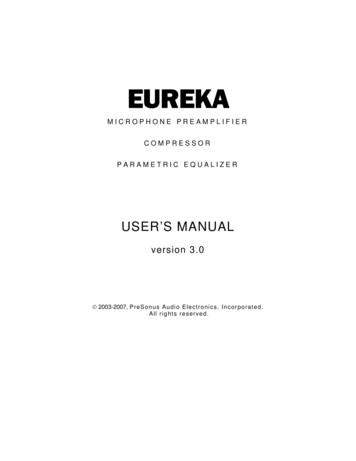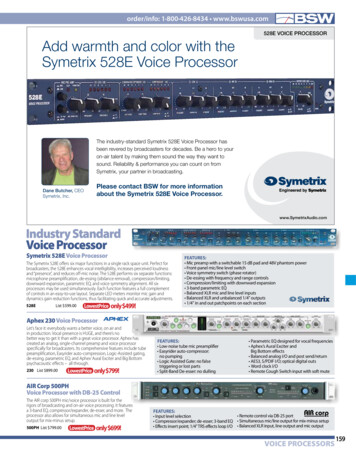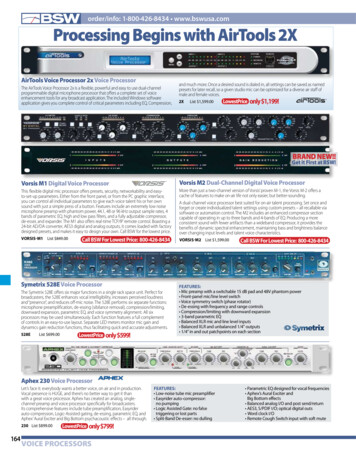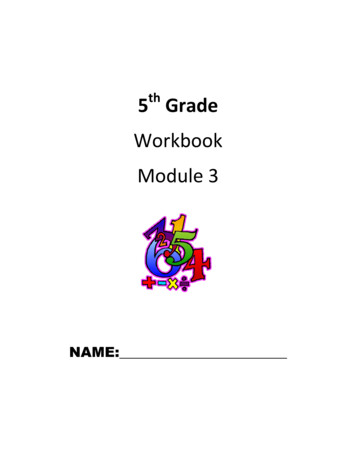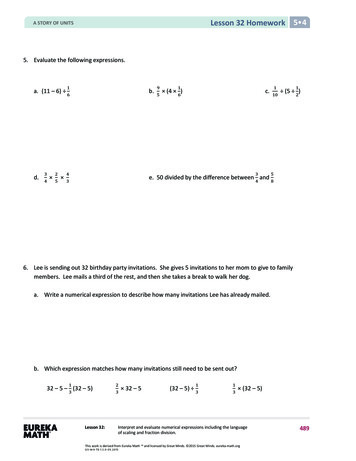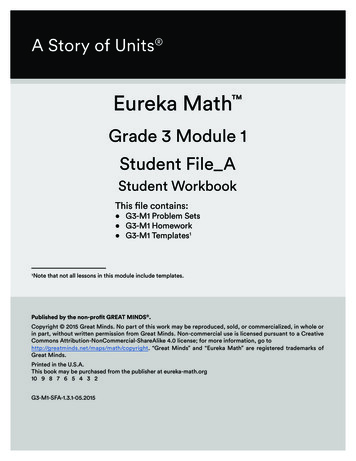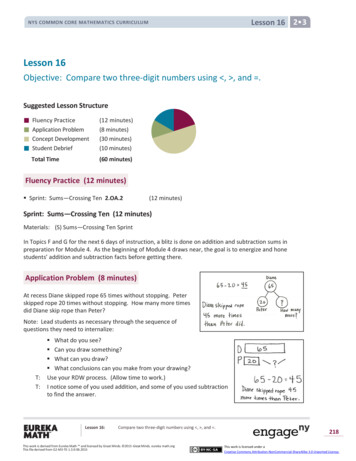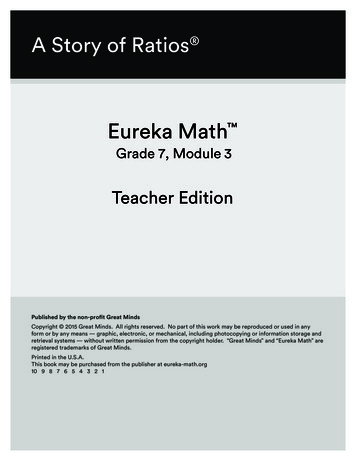
Transcription
A Story of Ratios Eureka Math Grade 7, Module 3Teacher EditionPublished by the non-profit Great MindsCopyright 2015 Great Minds. All rights reserved. No part of this work may be reproduced or used in anyform or by any means — graphic, electronic, or mechanical, including photocopying or information storage andretrieval systems — without written permission from the copyright holder. “Great Minds” and “Eureka Math” areregistered trademarks of Great Minds.Printed in the U.S.A.This book may be purchased from the publisher at eureka-math.org10 9 8 7 6 5 4 3 2 1
A STORY OF RATIOS7GRADEMathematics CurriculumGRADE 7 MODULE 3Table of Contents1Expressions and EquationsModule Overview . 3Topic A: Use Properties of Operations to Generate Equivalent Expressions (7.EE.A.1, 7.EE.A.2) . 12Lessons 1–2: Generating Equivalent Expressions . 13Lessons 3–4: Writing Products as Sums and Sums as Products . 48Lesson 5: Using the Identity and Inverse to Write Equivalent Expressions. 73Lesson 6: Collecting Rational Number Like Terms. 85Topic B: Solve Problems Using Expressions, Equations, and Inequalities (7.EE.B.3, 7.EE.B.4, 7.G.B.5) . 98Lesson 7: Understanding Equations . 100Lessons 8–9: Using If-Then Moves in Solving Equations . 113Lessons 10–11: Angle Problems and Solving Equations . 150Lesson 12: Properties of Inequalities . 171Lesson 13: Inequalities . 184Lesson 14: Solving Inequalities . 193Lesson 15: Graphing Solutions to Inequalities . 203Mid-Module Assessment and Rubric . 217Topics A through B (assessment 2 days, return 1 day, remediation or further applications 2 days)Topic C: Use Equations and Inequalities to Solve Geometry Problems (7.G.B.4, 7.G.B.6) . 239Lesson 16: The Most Famous Ratio of All . 241Lesson 17: The Area of a Circle . 252Lesson 18: More Problems on Area and Circumference . 262Lesson 19: Unknown Area Problems on the Coordinate Plane . 273Lesson 20: Composite Area Problems . 283Lessons 21–22: Surface Area . 295Lessons 23–24: The Volume of a Right Prism . 3201Eachlesson is ONE day, and ONE day is considered a 45-minute period.Module 3:Expressions and EquationsThis work is derived from Eureka Math and licensed by Great Minds. 2015 Great Minds. eureka-math.orgG7-M3-TE-1.3.0-06.20151
Module OverviewA STORY OF RATIOS7 3Lessons 25–26: Volume and Surface Area. 342End-of-Module Assessment and Rubric . 364Topics A through C (assessment 1 day, return 1 day, remediation or further applications 2 days)Module 3:Expressions and EquationsThis work is derived from Eureka Math and licensed by Great Minds. 2015 Great Minds. eureka-math.orgG7-M3-TE-1.3.0-06.20152
Module OverviewA STORY OF RATIOS7 3Grade 7 Module 3Expressions and EquationsOVERVIEWIn Grade 6, students interpreted expressions and equations as they reasoned about one-variable equations(6.EE.A.2). This module consolidates and expands upon students’ understanding of equivalent expressions asthey apply the properties of operations (associative, commutative, and distributive) to write expressions inboth standard form (by expanding products into sums) and in factored form (by expanding sums intoproducts). They use linear equations to solve unknown angle problems and other problems presented withincontext to understand that solving algebraic equations is all about the numbers. It is assumed that a numberalready exists to satisfy the equation and context; we just need to discover it. A number sentence is anequation that is said to be true if both numerical expressions evaluate to the same number; it is said to befalse otherwise. Students use the number line to understand the properties of inequality and recognize whento preserve the inequality and when to reverse the inequality when solving problems leading to inequalities.They interpret solutions within the context of problems. Students extend their sixth-grade study of geometricfigures and the relationships between them as they apply their work with expressions and equations to solveproblems involving area of a circle and composite area in the plane, as well as volume and surface area ofright prisms. In this module, students discover the most famous ratio of all, 𝜋𝜋, and begin to appreciate why ithas been chosen as the symbol to represent the Grades 6–8 mathematics curriculum, A Story of Ratios.To begin this module, students will generate equivalent expressions using the fact that addition andmultiplication can be done in any order with any grouping and will extend this understanding to subtraction(adding the inverse) and division (multiplying by the multiplicative inverse, also known as the reciprocal)(7.EE.A.1). They extend the properties of operations with numbers (learned in earlier grades) and recognizehow the same properties hold true for letters that represent numbers. Knowledge of rational numberoperations from Module 2 is demonstrated as students collect like terms containing both positive andnegative integers.An area model is used as a tool for students to rewrite products as sums and sums as products and to providea visual representation leading students to recognize the repeated use of the distributive property infactoring and expanding linear expressions (7.EE.A.1). Students examine situations where more than oneform of an expression may be used to represent the same context, and they see how looking at each form canbring a new perspective (and thus deeper understanding) to the problem. Students recognize and use theidentity properties and the existence of additive inverses to efficiently write equivalent expressions instandard form, for example, 2𝑥𝑥 ( 2𝑥𝑥) 3 0 3 3 (7.EE.A.2). By the end of the topic, students havethe opportunity to practice knowledge of operations with rational numbers gained in Module 2 (7.NS.A.1,7.NS.A.2) as they collect like terms with rational number coefficients (7.EE.A.1).In Topic B, students use linear equations and inequalities to solve problems (7.EE.B.4). They continue to usetape diagrams from earlier grades where they see fit, but will quickly discover that some problems wouldmore reasonably be solved algebraically (as in the case of large numbers). Guiding students to arrive at thisModule 3:Expressions and EquationsThis work is derived from Eureka Math and licensed by Great Minds. 2015 Great Minds. eureka-math.orgG7-M3-TE-1.3.0-06.20153
Module OverviewA STORY OF RATIOS7 3realization on their own develops the need for algebra. This algebraic approach builds upon work in Grade 6with equations (6.EE.B.6, 6.EE.B.7) to now include multi-step equations and inequalities containing rationalnumbers (7.EE.B.3, 7.EE.B.4). Students solve problems involving consecutive numbers; total cost; agecomparisons; distance, rate, and time; area and perimeter; and missing angle measures. Solving equationswith a variable is all about numbers, and students are challenged with the goal of finding the number thatmakes the equation true. When given in context, students recognize that a value exists, and it is simply theirjob to discover what that value is. Even the angles in each diagram have a precise value, which can bechecked with a protractor to ensure students that the value they find does indeed create a true numbersentence.In Topic C, students continue work with geometry as they use equations and expressions to study area,perimeter, surface area, and volume. This final topic begins by modeling a circle with a bicycle tire andcomparing its perimeter (one rotation of the tire) to the length across (measured with a string) to allowstudents to discover the most famous ratio of all, pi. Activities in comparing circumference to diameter arestaged precisely for students to recognize that this symbol has a distinct value and can be approximated by227, or 3.14, to give students an intuitive sense of the relationship that exists. In addition to representing thisvalue with the 𝜋𝜋 symbol, the fraction and decimal approximations allow for students to continue to practicetheir work with rational number operations. All problems are crafted in such a way as to allow students topractice skills in reducing within a problem, such as using227for finding circumference with a given diameterlength of 14 cm, and recognize what value would be best to approximate a solution. This understandingallows students to accurately assess work for reasonableness of answers. After discovering andunderstanding the value of this special ratio, students will continue to use pi as they solve problems of areaand circumference (7.G.B.4).In this topic, students derive the formula for area of a circle by dividing a circle of radius 𝑟𝑟 into pieces of piand rearranging the pieces so that they are lined up, alternating direction, and form a shape that resembles a1rectangle. This “rectangle” has a length that is the circumference and a width of 𝑟𝑟. Students determine2that the area of this rectangle (reconfigured from a circle of the same area) is the product of its length and itswidth:121𝐶𝐶 𝑟𝑟 2𝜋𝜋𝜋𝜋 𝑟𝑟 𝜋𝜋𝑟𝑟2 (7.G.B.4). The precise definitions for diameter, circumference, pi, and2circular region or disk will be developed during this topic with significant time being devoted to students’understanding of each term.Students build upon their work in Grade 6 with surface area and nets to understand that surface area issimply the sum of the area of the lateral faces and the base(s) (6.G.A.4). In Grade 7, they continue to solvereal-life and mathematical problems involving area of two-dimensional shapes and surface area and volumeof prisms (e.g., rectangular, triangular), focusing on problems that involve fractional values for length(7.G.B.6). Additional work (examples) with surface area will occur in Module 6 after a formal definition ofrectangular pyramid is established.This module is comprised of 26 lessons; 9 days are reserved for administering the Mid-Module and End-ofModule Assessments, returning the assessments, and remediating or providing further applications of theconcepts. The Mid-Module Assessment follows Topic B, and the End-of-Module Assessment follows Topic C.Module 3:Expressions and EquationsThis work is derived from Eureka Math and licensed by Great Minds. 2015 Great Minds. eureka-math.orgG7-M3-TE-1.3.0-06.20154
Module OverviewA STORY OF RATIOS7 3Focus StandardsUse properties of operations to generate equivalent expressions.7.EE.A.1Apply properties of operations as strategies to add, subtract, factor, and expand linearexpressions with rational coefficients.7.EE.A.2Understand that rewriting an expression in different forms in a problem context can shedlight on the problem and how the quantities in it are related. For example,𝑎𝑎 0.05𝑎𝑎 1.05𝑎𝑎 means that “increase by 5%” is the same as “multiply by 1.05.”Solve real-life and mathematical problems using numerical and algebraic expressions andequations.7.EE.B.37.EE.B.4Solve multi-step real-life and mathematical problems posed with positive and negativerational numbers in any form (whole numbers, fractions, and decimals), using toolsstrategically. Apply properties of operations to calculate with numbers in any form; convertbetween forms as appropriate; and assess the reasonableness of answers using mentalcomputation and estimation strategies. For example: If a woman making 25 an hour getsa 10% raise, she will make an additional 1/10 of her salary an hour, or 2.50, for a newsalary of 27.50. If you want to place a towel bar 9 3/4 inches long in the center of a doorthat is 27 1/2 inches wide, you will need to place the bar about 9 inches from each edge;this estimate can be used as a check on the exact computation.Use variables to represent quantities in a real-world or mathematical problem, andconstruct simple equations and inequalities to solve problems by reasoning about thequantities.a.b.Solve word problems leading to equations of the form 𝑝𝑝𝑝𝑝 𝑞𝑞 𝑟𝑟 and 𝑝𝑝(𝑥𝑥 𝑞𝑞) 𝑟𝑟,where 𝑝𝑝, 𝑞𝑞, and 𝑟𝑟 are specific rational numbers. Solve equations of these formsfluently. Compare an algebraic solution to an arithmetic solution, identifying thesequence of the operations used in each approach. For example, the perimeter of arectangle is 54 cm. Its length is 6 cm. What is its width?Solve word problems leading to inequalities of the form 𝑝𝑝𝑝𝑝 𝑞𝑞 𝑟𝑟 or 𝑝𝑝𝑝𝑝 𝑞𝑞 𝑟𝑟,where 𝑝𝑝, 𝑞𝑞, and 𝑟𝑟 are specific rational numbers. Graph the solution set of theinequality and interpret it in the context of the problem. For example: As asalesperson, you are paid 50 per week plus 3 per sale. This week you want your payto be at least 100. Write an inequality for the number of sales you need to make, anddescribe the solutions.Solve real-life and mathematical problems involving angle measure, area, surface area, andvolume.7.G.B.4Know the formulas for the area and circumference of a circle and use them to solveproblems; give an informal derivation of the relationship between the circumference andarea of a circle.Module 3:Expressions and EquationsThis work is derived from Eureka Math and licensed by Great Minds. 2015 Great Minds. eureka-math.orgG7-M3-TE-1.3.0-06.20155
Module OverviewA STORY OF RATIOS7 37.G.B.5Use facts about supplementary, complementary, vertical, and adjacent angles in a multistep problem to write and solve simple equations for an unknown angle in a figure.7.G.B.6Solve real-world and mathematical problems involving area, volume and surface area oftwo- and three-dimensional objects composed of triangles, quadrilaterals, polygons, cubes,and right prisms.Foundational StandardsUnderstand and apply properties of operations and the relationship between addition andsubtraction.1.OA.B.3Apply properties of operations as strategies to add and subtract. 2 Examples: If 8 3 11is known, then 3 8 11 is also known. (Commutative property of addition.) To add2 6 4, the second two numbers can be added to make a ten, so2 6 4 2 10 12. (Associative property of addition.)Understand properties of multiplication and the relationship between multiplication anddivision.3.OA.B.5Apply properties of operations as strategies to multiply and divide.2 Examples: If6 4 24 is known, then 4 6 24 is also known. (Commutative property ofmultiplication.) 3 5 2 can be found by 3 5 15, then 15 2 30, or by 5 2 10,then 3 10 30. (Associative property of multiplication.) Knowing that 8 5 40 and8 2 16, one can find 8 7 as 8 (5 2) (8 5) (8 2) 40 16 56.(Distributive property.)Geometric measurement: understand concepts of angle and measure angles.4.MD.C.5Recognize angles as geometric shapes that are formed wherever two rays share a commonendpoint, and understand concepts of angle measurement:a.b.4.MD.C.62StudentsAn angle is measured with reference to a circle with its center at the common endpointof the rays, by considering the fraction of the circular arc between the points where thetwo rays intersect the circle. An angle that turns through 1/360 of a circle is called a“one-degree angle,” and can be used to measure angles.An angle that turns through 𝑛𝑛 one-degree angles is said to have an angle measure of 𝑛𝑛degrees.Measure angles in whole-number degrees using a protractor. Sketch angles of specifiedmeasure.need not use formal terms for these properties.Module 3:Expressions and EquationsThis work is derived from Eureka Math and licensed by Great Minds. 2015 Great Minds. eureka-math.orgG7-M3-TE-1.3.0-06.20156
Module OverviewA STORY OF RATIOS4.MD.C.77 3Recognize angle measure as additive. When an angle is decomposed into non-overlappingparts, the angle measure of the whole is the sum of the angle measures of the parts. Solveaddition and subtraction problems to find unknown angles on a diagram in real world andmathematical problems, e.g., by using an equation with a symbol for the unknown anglemeasure.Apply and extend previous understandings of arithmetic to algebraic expressions.6.EE.A.36.EE.A.4Apply the properties of operations to generate equivalent expressions. For example, applythe distributive property to the expression 3(2 𝑥𝑥) to produce the equivalent expression6 3𝑥𝑥; apply the distributive property to the expression 24𝑥𝑥 18𝑦𝑦 to produce theequivalent expression 6(4𝑥𝑥 3𝑦𝑦); apply properties of operations to 𝑦𝑦 𝑦𝑦 𝑦𝑦 to producethe equivalent expression 3𝑦𝑦.Identify when two expressions are equivalent (i.e., when the two expressions name thesame number regardless of which value is substituted into them). For example, theexpressions 𝑦𝑦 𝑦𝑦 𝑦𝑦 and 3𝑦𝑦 are equivalent because they name the same numberregardless of which number 𝑦𝑦 stands for.Reason about and solve one-variable equations and inequalities.6.EE.B.6Use variables to represent numbers and write expressions when solving a real-world ormathematical problem; understand that a variable can represent an unknown number, or,depending on the purpose at hand, any number in a specified set.6.EE.B.7Solve real-world and mathematical problems by writing and solving equations in the form𝑥𝑥 𝑝𝑝 𝑞𝑞 and 𝑝𝑝𝑝𝑝 𝑞𝑞 for cases in which 𝑝𝑝, 𝑞𝑞, and 𝑥𝑥 are all nonnegative rational numbers.6.EE.B.8Write an inequality of the form 𝑥𝑥 𝑐𝑐 or 𝑥𝑥 𝑐𝑐 to represent a constraint or condition in areal-world mathematical problem. Recognize that inequalities of the form 𝑥𝑥 𝑐𝑐 or 𝑥𝑥 𝑐𝑐have infinitely many solutions; represent solutions of such inequalities on number linediagrams.Solve real-world and mathematical problems involving area, surface area, and volume.6.G.A.1Find the area of right triangles, other triangles, special quadrilaterals, and polygons bycomposing into rectangles or decomposing into triangles and other shapes; apply thesetechniques in the context of solving real-world and mathematical problems.6.G.A.2Find the volume of a right rectangular prism with fractional edge lengths by packing it withunit cubes of the appropriate unit fraction edge lengths, and show that the volume is thesame as would be found by multiplying the edge lengths of the prism. Apply the formulas𝑉𝑉 𝑙𝑙𝑙𝑙ℎ and 𝑉𝑉 𝑏𝑏ℎ to find volumes of right rectangular prisms with fractional edgelengths in the context of solving real-world and mathematical problems.6.G.A.4Represent three-dimensional figures using nets made up of rectangles and triangles, and usethe nets to find the surface area of these figures. Apply these techniques in the context ofsolving real-world and mathematical problems.Module 3:Expressions and EquationsThis work is derived from Eureka Math and licensed by Great Minds. 2015 Great Minds. eureka-math.orgG7-M3-TE-1.3.0-06.20157
Module OverviewA STORY OF RATIOS7 3Apply and extend previous understandings of operations with fractions to add, subtract,multiply, and divide rational numbers.7.NS.A.1Apply and extend previous understandings of addition and subtraction to add and subtractrational numbers; represent addition and subtraction on a horizontal or vertical number linediagram.a.b.7.NS.A.2Describe situations in which opposite quantities combine to make 0. For example, ahydrogen atom has 0 charge because its two constituents are oppositely charged.Understand 𝑝𝑝 𝑞𝑞 as the number located a distance 𝑞𝑞 from 𝑝𝑝, in the positive ornegative direction depending on whether 𝑞𝑞 is positive or negative. Show that a numberand its opposite have a sum of 0 (are additive inverses). Interpret sums of rationalnumbers by describing real-world contexts.c.Understand subtraction of rational numbers as adding the additive inverse,𝑝𝑝 𝑞𝑞 𝑝𝑝 ( 𝑞𝑞). Show that the distance between two rational numbers on thenumber line is the absolute value of their difference, and apply this principle in realworld contexts.d.Apply properties of operations as strategies to add and subtract rational numbers.Apply and extend previous understandings of multiplication and division and of fractions tomultiply and divide rational numbers.a.Understand that multiplication is extended from fractions to rational numbers byrequiring that operations continue to satisfy the properties of operations, particularlythe distributive property, leading to products such as ( 1)( 1) 1 and the rules formultiplying signed numbers. Interpret products of rational numbers by describing realworld contexts.b.Understand that integers can be divided, provided that the divisor is not zero, andevery quotient of integers (with non-zero divisor) is a rational number. If 𝑝𝑝 and 𝑞𝑞 areintegers, then (𝑝𝑝/𝑞𝑞) ( 𝑝𝑝)/𝑞𝑞 𝑝𝑝/( 𝑞𝑞). Interpret quotients of rational numbersby describing real-world contexts.c.d.Apply properties of operations as strategies to multiply and divide rational numbers.Convert a rational number to a decimal using long division; know that the decimal formof a rational number terminates in 0s or eventually repeats.Focus Standards for Mathematical PracticeMP.2Reason abstractly and quantitatively. Students make sense of how quantities are relatedwithin a given context and formulate algebraic equations to represent this relationship.They use the properties of operations to manipulate the symbols that are used in place ofnumbers, in particular, pi. In doing so, students reflect upon each step in solving andrecognize that these properties hold true since the variable is really just holding the placefor a number. Students analyze solutions and connect back to ensure reasonableness withincontext.Module 3:Expressions and EquationsThis work is derived from Eureka Math and licensed by Great Minds. 2015 Great Minds. eureka-math.orgG7-M3-TE-1.3.0-06.20158
Module OverviewA STORY OF RATIOS7 3MP.4Model with mathematics. Throughout the module, students use equations and inequalitiesas models to solve mathematical and real-world problems. In discovering the relationshipbetween circumference and diameter in a circle, they will use real objects to analyze therelationship and draw conclusions. Students test conclusions with a variety of objects to seeif the results hold true, possibly improving the model if it has not served its purpose.MP.6Attend to precision. Students are precise in defining variables. They understand that avariable represents one number. They use appropriate vocabulary and terminology whencommunicating about expressions, equations, and inequalities. They use the definition ofequation from Grade 6 to understand how to use the equal sign consistently andappropriately. Circles and related notions about circles are precisely defined in this module.MP.7Look for and make use of structure. Students recognize the repeated use of the distributiveproperty as they write equivalent expressions. Students recognize how equations leading tothe form 𝑝𝑝𝑝𝑝 𝑞𝑞 𝑟𝑟 and 𝑝𝑝(𝑥𝑥 𝑞𝑞) 𝑟𝑟 are useful in solving a variety of problems. They seepatterns in the way that these equations are solved. Students apply this structure as theyunderstand the similarities and differences in how an inequality of the type 𝑝𝑝𝑝𝑝 𝑞𝑞 𝑟𝑟 or𝑝𝑝𝑝𝑝 𝑞𝑞 𝑟𝑟 is solved.MP.8Look for and express regularity in repeated reasoning. Students use area models to writeproducts as sums and sums as products and recognize how this model is a way to organizeresults from repeated use of the distributive property. As students work to solve problems,they maintain oversight of the process, while attending to the details. They continuallyevaluate the reasonableness of solutions as they are represented in contexts that allow forstudents to know that they found the intended value for a given variable. As they solveproblems involving pi, they notice how a problem may be reduced by using a given estimatefor pi to make calculations more efficient.TerminologyNew or Recently Introduced Terms An Expression in Expanded Form (description) (An expression that is written as sums (and/ordifferences) of products whose factors are numbers, variables, or variables raised to whole numberpowers is said to be in expanded form. A single number, variable, or a single product of numbersand/or variables is also considered to be in expanded form.)An Expression in Factored Form (description) (An expression that is a product of two or moreexpressions is said to be in factored form.)An Expression in Standard Form (description) (An expression that is in expanded form where all liketerms have been collected is said to be in standard form.)Circle (Given a point 𝑂𝑂 in the plane and a number 𝑟𝑟 0, the circle with center 𝑂𝑂 and radius 𝑟𝑟 is theset of all points in the plane whose distance from the point 𝑂𝑂 is equal to 𝑟𝑟.)Circular Region or Disk (Given a point 𝐶𝐶 in the plane and a number 𝑟𝑟 0, the circular region (ordisk) with center 𝐶𝐶 and radius 𝑟𝑟 is the set of all points in the plane whose distance from the point 𝐶𝐶 isless than or equal to 𝑟𝑟.)Module 3:Expressions and EquationsThis work is derived from Eureka Math and licensed by Great Minds. 2015 Great Minds. eureka-math.orgG7-M3-TE-1.3.0-06.20159
Module OverviewA STORY OF RATIOS7 3Circumference (The circumference of a circle is the distance around the circle.) 3Coefficient of a Term (The coefficient of a term is the number found by multiplying all of the numberfactors in a term together.)Diameter of a Circle (The diameter of a circle is the length of any segment that passes through thecenter of a circle whose endpoints lie on the circle.If 𝑟𝑟 is the radius of a circle, then the diameter is 2𝑟𝑟.)Interior of a Circle (The interior of a circle with center 𝐶𝐶 and radius 𝑟𝑟 is the set of all points in theplane whose distance from the point 𝐶𝐶 is less than 𝑟𝑟.)Pi (The number pi, denoted 𝜋𝜋, is the value of the ratio given by the circumference to the diameter,that is, 𝜋𝜋 (circumference)/(diameter).)Term (description) (Each summand of an expression in expanded form is called a term.) Familiar Terms and Symbols 4Adjacent AnglesCubeDistributeEquationEquivalent ExpressionsExpression (middle school description)FactorFigureIdentityInequalityLength of a SegmentLinear ExpressionMeasure of an AngleNumber SentenceNumerical Expression (middle school description)Properties of Operations (distributive, commutative, associative)Right Rectangular PrismSegmentSquareSurface of a PrismTermTriangle 3“Distance4Thesearound a circular arc” is taken as an undefined term in G-CO.1.are terms and symbols students have seen previously.Module 3:Expressions and EquationsThis work is derived from Eureka Math and licensed by Great Minds. 2015 Great Minds. eureka-math.orgG7-M3-TE-1.3.0-06.201510
Module OverviewA STORY OF RATIOS 7 3True or False Number SentenceTruth Values of a Number SentenceValue of a Numerical ExpressionVariable (middle school description)Vertical AnglesSuggested Tools and Representations Area ModelCoordinate PlaneEquations and InequalitiesExpressionsGeometric FiguresNets for Three-Dimensional FiguresNumber LineProtractorTape DiagramAssessment SummaryAssessment Type AdministeredFormatStandards AddressedMid-ModuleAssessment TaskAfter Topic BConstructed response with rubric7.EE.A.1, 7.EE.A.2,7.EE.B.3, 7.EE.B.4,7.G.B.5End-of-ModuleAssessment TaskAfter Topic CConstructed response with rubric7.EE.A.1, 7.EE.A.2,7.G.B.4, 7.G.B.5, 7.G.B.6Module 3:Expressions and EquationsThis work is derived from Eureka Math and licensed by Great Minds. 2015 Great Minds. eureka-math.orgG7-M3-TE-1.3.0-06.201511
A STORY OF RATIOS7Mathematics CurriculumGRADEGRADE 7 MODULE 3Topic AUse Properties of Operations to GenerateEquivalent Expressions7.EE.A.1, 7.EE.A.2Focus Standards:Instructional Days:7.EE.A.1Apply properties of operations as strategies to add, subtract, factor, andexpand linear expressions with rational coefficients.7.EE.A.2Understand that rewriting an expression in different forms in a problemcontext can shed light on the problem and how the quantities in it are related.For example, 𝑎𝑎 0.05𝑎𝑎 1.05𝑎𝑎 means that “increase by 5%” is the same as“multiply by 1.05.”6Lessons 1–2: Generating Equivalent Expressions (P) 1Lessons 3–4: Writing Products as Sums and Sums as Products (P)Lesson 5
1Each lesson is ONE day, and ONE day is considered a 45-minute period. This work is derived from Eureka Math and licensed by Great Minds. 2015 Great Minds. eureka-math.org G7-M3-TE-1.3.0-06.2015
